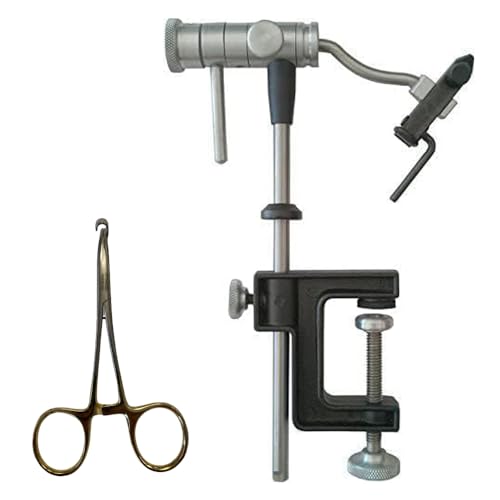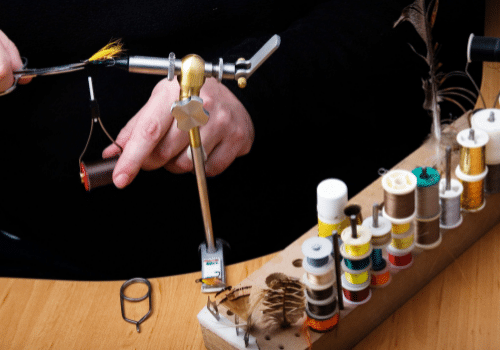The Rundown
Best Overall: Peak Rotary Vise (click to see)
“Peak Rotary is durable since it’s composed of stainless steel brass, tool steel, and aircraft aluminum. If you tie several flies at once, you’ll like its integrated hook and two accessory post mounting holes.”
Best Beginner Vise: Griffin Spider Vise (click to see)
“Griffin Spider is excellent if you are new to fly tying and are looking for great-quality vise at an affordable price. Purchase with confidence as this comes with a lifetime warranty.”
Most Versatile: Griffin Montana Mongoose Vise (click to see)
“The Montana Mongoose has 360-degree rotational capabilities that allow you to turn it at any angle. It has a series of locking and fine tension screws that rotate the vise precisely.”
For the avid fly fishermen, there are few things as enjoyable as tying your flies. Doing so allows you to customize each fly to your liking, which typically bolsters an angler’s confidence.
There is something truly magical about boating a trout that has been caught on a hand-tied fly. However, a certain amount of gear is necessary to begin tying your flies, including a fly vise.
Premium fly tying vises feature only the most durable components and are highly adjustable, allowing an angler to arrange every facet of their fly tying effort as they see fit.




Best Fly Tying Vise For The Money
Our Top 5 Picks
Table of Contents
Best Fly Tying Vises 2024
Here’s the top 5 fly tying vises that can help you customize your next fly:
- Peak Rotary Vise
- Griffin Spider Vise
- Griffin Montana Mongoose Vise
- Atlas Rotary Fly Tying Vise
- Colorado Anglers 2001 EZ Rotary Vise
Peak Rotary Vise
Best Overall: A durable vise that offers every feature one could ask for

KEY FEATURES
- Broad footprint pedestal base for increased stability
- Rugged construction for enhanced durability
- hook/bead pocket and accessory holes for greater efficiency
If you are currently in the market for a premium pedestal base mount vise that is packed full of helpful features, then the Peak Rotary Vise should be on your radar. This vise features a broad mount base for increased stability, powder-coated to improve its overall longevity.
CLICK TO SEE MORE
Griffin Spider Vise
Best Beginner Vise: Excellent quality at a more than reasonable price

KEY FEATURES
- Rotary design for ease of access
- Hearty design for increased durability
- Lifetime warranty for peace of mind
If you are currently new to fly tying and looking for a quality vise at an entry-level price, it would be difficult to go wrong with the Griffin Odyssey Spider. This C-clamp style vise is constructed from a premium-grade material and features a 28 to 4/0 jaw capacity, making it inherently versatile.
CLICK TO SEE MORE
Griffin Montana Mongoose Vise
Most Versatile: A vise that can be used virtually anywhere

KEY FEATURES
- Comes with pedestal and C-clamp mounts for unparalleled durability
- 360-degree rotation for ease of access
- Locking and fine tension screws for precise adjustability
The Griffin Montana Mongoose Vise should be the perfect choice for any angler who is looking for a highly versatile vise that can be used in virtually any setting that one might imagine. Additionally, this vice comes with two different mounts, of both a pedestal and C-clamp style. This allows an angler to tie just as efficiently when traveling to a remote fishing destination as when sitting in the comfort of their own home.
CLICK TO SEE MORE
Wolff Indiana Atlas Vise
Best High-End Vise: Designed with user comfort in mind

KEY FEATURES
- Numerous micro-adjustments for added efficiency and comfort
- Wide range of compatible hook sizes for increased versatility
- Stainless steel construction for ultimate durability
The Atlas Rotary Fly Tying Vise provides anglers with numerous adjustments to ensure that they can work in the utmost comfort, even during prolonged periods of use. This should be perfect for those that tie a substantial number of flies regularly. The Atlas Rotary Fly Tying Vise features a separate tying friction and spindle lock, long-throw cam action lock up, and extended finger pin with ball end for easy wrapping.
CLICK TO SEE MORE
Colorado Anglers 2001 EZ Rotary Vise
Best Budget Vise: A vise that can be purchased at any budget

KEY FEATURES
- Low-profile jaws for precise retention
- 360-degree rotation for enhanced accessibility
- Lightweight design for ease of portability
If you are looking for a quality fly tying vise, yet are operating on a fairly restrictive budget, then the Colorado Anglers 2001 EZ Rotary Vise should be exactly what you need. This vise features a C-clamp style mount and a low profile jaw, which is likely to be ideal when working with smaller hooks yet carries a retail price that costs less than what many anglers spend on a tank of fuel for their vehicles.
CLICK TO SEE MORE
Buyers Guide: What You Need to Know
C-Clamp vs Pedestal
Fly tying vises come in two main types of mounting configurations; C-Clamp and Pedestal. Each of these two styles carries its merit, as well as disadvantages. Therefore, to select the option which best suits your needs, it is essential to understand the nuances of each configuration.
C-Clamp
A C-clamp style fly tying vise clamps to a table or desktop, serving as its mount point. This vise style is relatively easy to set up and is easy to store away for the season when your fly tying duties are complete. C-Clamp Style vises are also lightweight by design, making them relatively simple to maneuver and anchor in place.
Pedestal
A pedestal-style fly tying vise features a flat base, which you can place upon any smooth, level surface. This means that you can use a pedestal vise on a table, counter, or even a boat seat. This can be pretty handy, especially when traveling for the fishing trip of your dreams. Pedestal vises also tend to be easy to carry, making them ideal for use on the road.
In the vast majority of cases, the task of selecting which style of vise to purchase comes down to a matter of personal preference. While some anglers quickly flock to pedestal-style vises, others remain very fond of C-Clamp vises and feel that they offer a superior range of adjustment.
Fixed Jaw vs Rotary
Another important consideration when selecting fly tying vises for purchase is choosing a fixed jaw or rotary model. While many anglers automatically assume the rotary fly tying vise is superior to its fixed jaw counterpart, 360-degree rotation is not always necessary to tie a quality fly. In any event, every angler should understand the differences between each style of the vise.
Fixed Jaw
As its name would suggest, the fixed jaw vise is completely stationary and offers no degree of rotation. Therefore, when set in place, an angler must work around the vise itself, rather than simply rotating their vise to achieve the exact work angle, which is preferred. While a rotary fly tying vise is undoubtedly more efficient in access, quality flys can indeed be tied on a fixed jaw vice with a bit of practice.
Rotary
A rotary-style fly tying vice allows an angler to manipulate the angle at which their fly sits. This provides a greater amount of access when attempting to arrange each fly as intended. While a rotary vise will not make you better at fly tying, it will allow you to be more efficient in your endeavors and possibly save you a little time along the way.
Questions & Answers

How to use a fly fishing vise?
A fly vise is used to support the hook of a fly, thereby allowing an angler to work around this hook as they see fit. To get started tying flies, you must first set up a vise. To do this, begin by adjusting the height of your vise. Ideally, the vise needs to be set at a comfortable level when tying is in progress, whether from a standing or sitting position. Using the swivel, adjust the holding jaws to a level that is only a short distance above the desktop clamp.
Next, you will open the jaws of your vise using the unit’s rotary shaft. Place your hook in line with the jaws of your vise, and tighten it in place, again using the rotary shaft to facilitate these adjustments. Before beginning work, it is crucial to verify that you are happy with the positioning of your vise. If anything appears as if it would impede progress, make any minor adjustment tweaks now.
Also worth mentioning is that your vise can be repositioned at any time during the fly tying process to achieve better results.

Is fly tying worth it?
In the world of fly fishing, the debate continues as to whether or not fly tying is a worthwhile venture. While proponents state that tying flies is an excellent way to save money, others claim that you can save no true money over purchasing flies outright at a local retailer. So naturally, this begs the question, is fly tying worth it?
Purely from a financial standpoint, tying flies makes sense in an angler who fishes quite frequently. This is because one must expend a certain amount of money to procure all needed when jumping into the world of fly tying. Therefore, an angler who fishes regularly and typically goes through many flies in a given year will offset the purchase price of these materials far quicker than someone who only fishes 1-2 times a year.
However, the actual value of fly tying goes far beyond cost savings. There is little that brings as much excitement to a fly fisher as watching a rainbow trout strike a fly that they tied. This provides anglers with a sense of pride at a job well done and leaves one feeling even more determined to soldier on in their fly tying endeavors.



